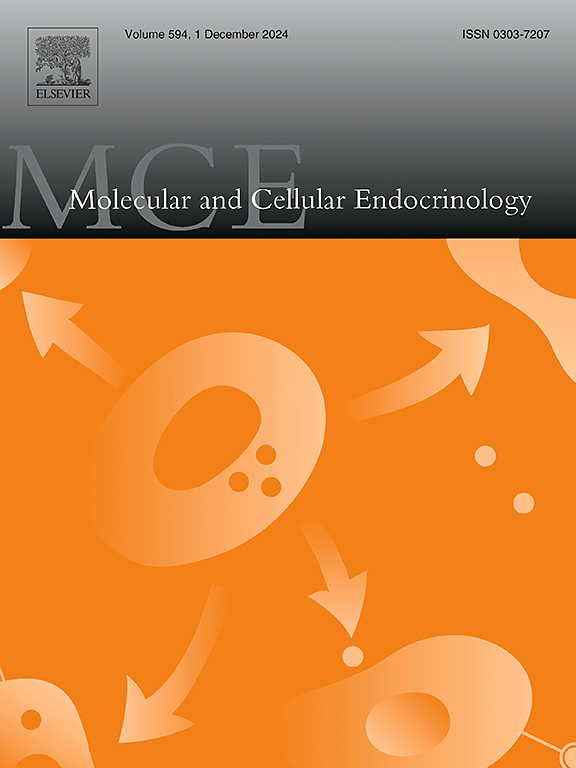CYR61和CTGF介导双调节蛋白对人颗粒叶黄素细胞COX-2表达的刺激作用
IF 3.6
3区 医学
Q2 CELL BIOLOGY
引用次数: 0
摘要
双调节蛋白(AREG)是一种表皮生长因子(EGF)样配体,是人卵泡液中主要的表皮生长因子受体(EGFR)配体,介导促黄体生成素(LH)对卵巢功能的影响。在本研究中,我们研究了AREG是否调节富半胱氨酸血管生成诱导因子61 (CYR61)和结缔组织生长因子(CTGF)这两个参与卵巢功能的关键基质细胞蛋白的表达,以及它们是否介导AREG诱导的环氧化酶-2 (COX-2)表达。利用人颗粒细胞肿瘤源性KGN细胞系和原代人颗粒叶黄素(hGL)细胞,我们证明了AREG处理以egfr依赖的方式上调CYR61和CTGF蛋白水平。机制分析显示,areg诱导CYR61和CTGF的表达是通过ERK1/2、AKT、CREB和YAP信号通路介导的。使用特异性抑制剂或小干扰RNA抑制这些途径可阻断areg诱导的CYR61和CTGF的表达,表明它们在这一过程中发挥重要作用。此外,CYR61和CTGF的下调减弱了AREG诱导的COX-2表达,确立了它们作为人颗粒细胞AREG信号传导的关键介质的作用。最后,我们的研究结果表明,LH处理诱导CYR61和CTGF的表达,并且这种诱导被EGFR抑制减弱。此外,CYR61和CTGF的下调降低了lh诱导的COX-2表达。这些发现为研究AREG调控卵巢功能的分子机制提供了新的见解,并突出了生殖健康研究的潜在目标。本文章由计算机程序翻译,如有差异,请以英文原文为准。
CYR61 and CTGF mediate the stimulatory effect of amphiregulin on COX-2 expression in human granulosa-lutein cells
Amphiregulin (AREG), an epidermal growth factor (EGF)-like ligand, is the predominant epidermal growth factor receptor (EGFR) ligand in human follicular fluid and mediates the effects of luteinizing hormone (LH) on ovarian function. In this study, we investigated whether AREG regulates the expression of cysteine-rich angiogenic inducer 61 (CYR61) and connective tissue growth factor (CTGF), two key matricellular proteins involved in ovarian function, and whether they mediate AREG-induced cyclooxygenase-2 (COX-2) expression. Using the human granulosa cell tumor-derived KGN cell line and primary human granulosa-lutein (hGL) cells, we demonstrated that AREG treatment upregulated CYR61 and CTGF protein levels in an EGFR-dependent manner. Mechanistic analysis revealed that AREG-induced expression of CYR61 and CTGF was mediated through the ERK1/2, AKT, CREB, and YAP signaling pathways. Inhibition of these pathways using specific inhibitors or small interfering RNA blocked AREG-induced CYR61 and CTGF expression, indicating their essential roles in this process. Moreover, knockdown of CYR61 and CTGF attenuated AREG-induced COX-2 expression, establishing their role as key mediators of AREG signaling in human granulosa cells. Finally, our results showed that LH treatment induced the expression of CYR61 and CTGF, and this induction was attenuated by EGFR inhibition. Moreover, knockdown of CYR61 and CTGF reduced LH-induced COX-2 expression. These findings provide novel insights into the molecular mechanisms by which AREG regulates ovarian function and highlight potential targets for reproductive health research.
求助全文
通过发布文献求助,成功后即可免费获取论文全文。
去求助
来源期刊

Molecular and Cellular Endocrinology
医学-内分泌学与代谢
CiteScore
9.00
自引率
2.40%
发文量
174
审稿时长
42 days
期刊介绍:
Molecular and Cellular Endocrinology was established in 1974 to meet the demand for integrated publication on all aspects related to the genetic and biochemical effects, synthesis and secretions of extracellular signals (hormones, neurotransmitters, etc.) and to the understanding of cellular regulatory mechanisms involved in hormonal control.
 求助内容:
求助内容: 应助结果提醒方式:
应助结果提醒方式:


